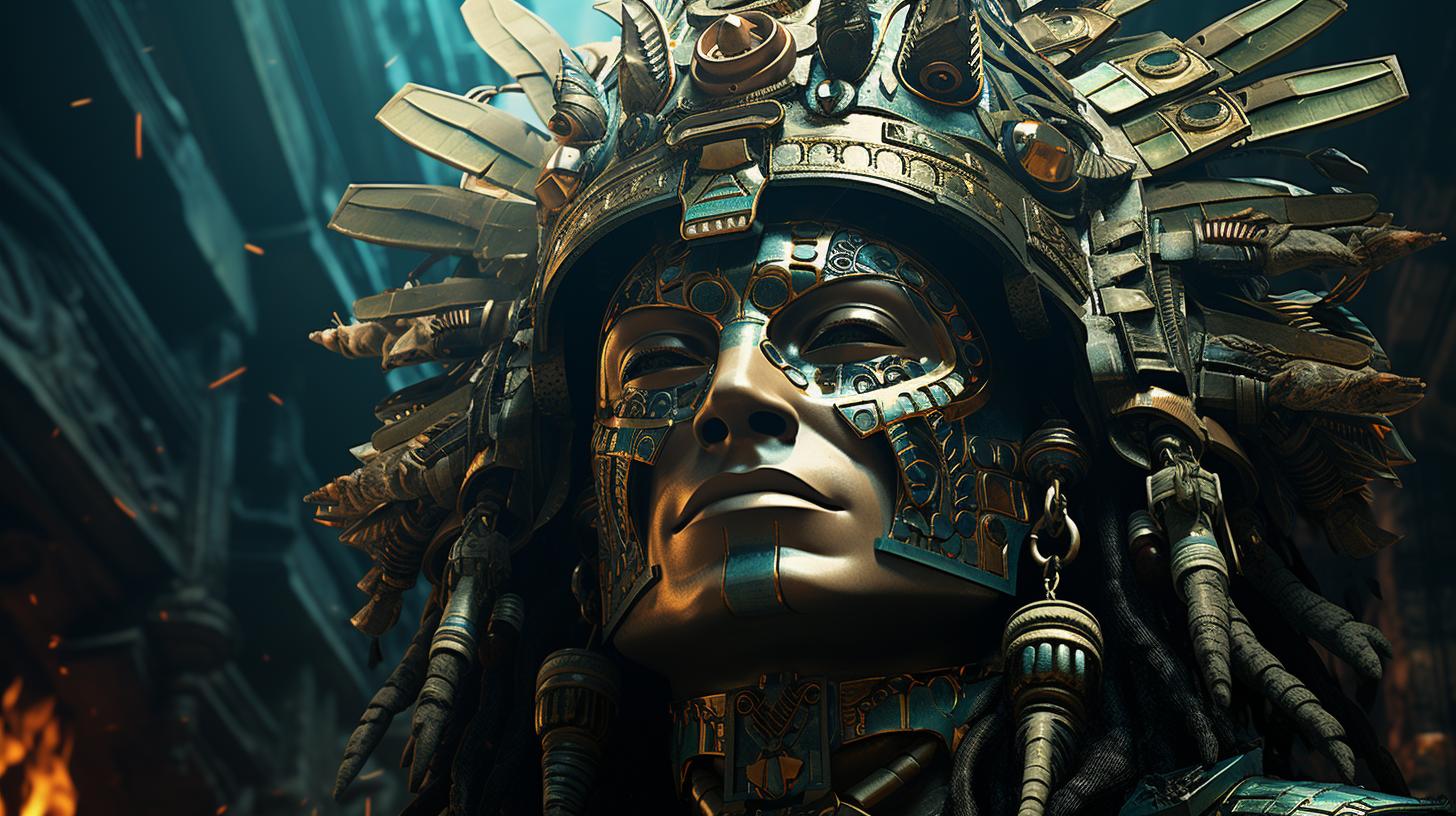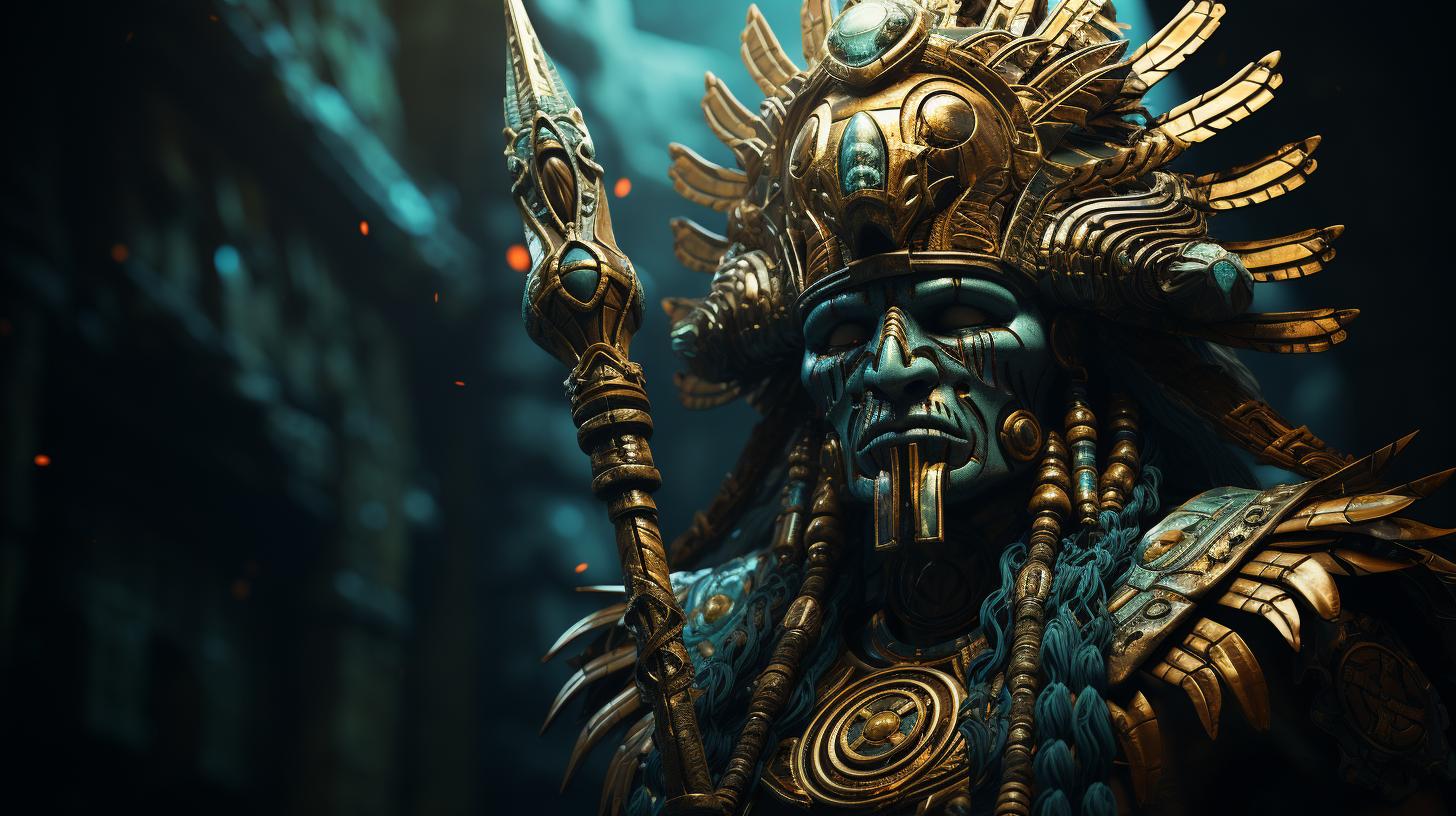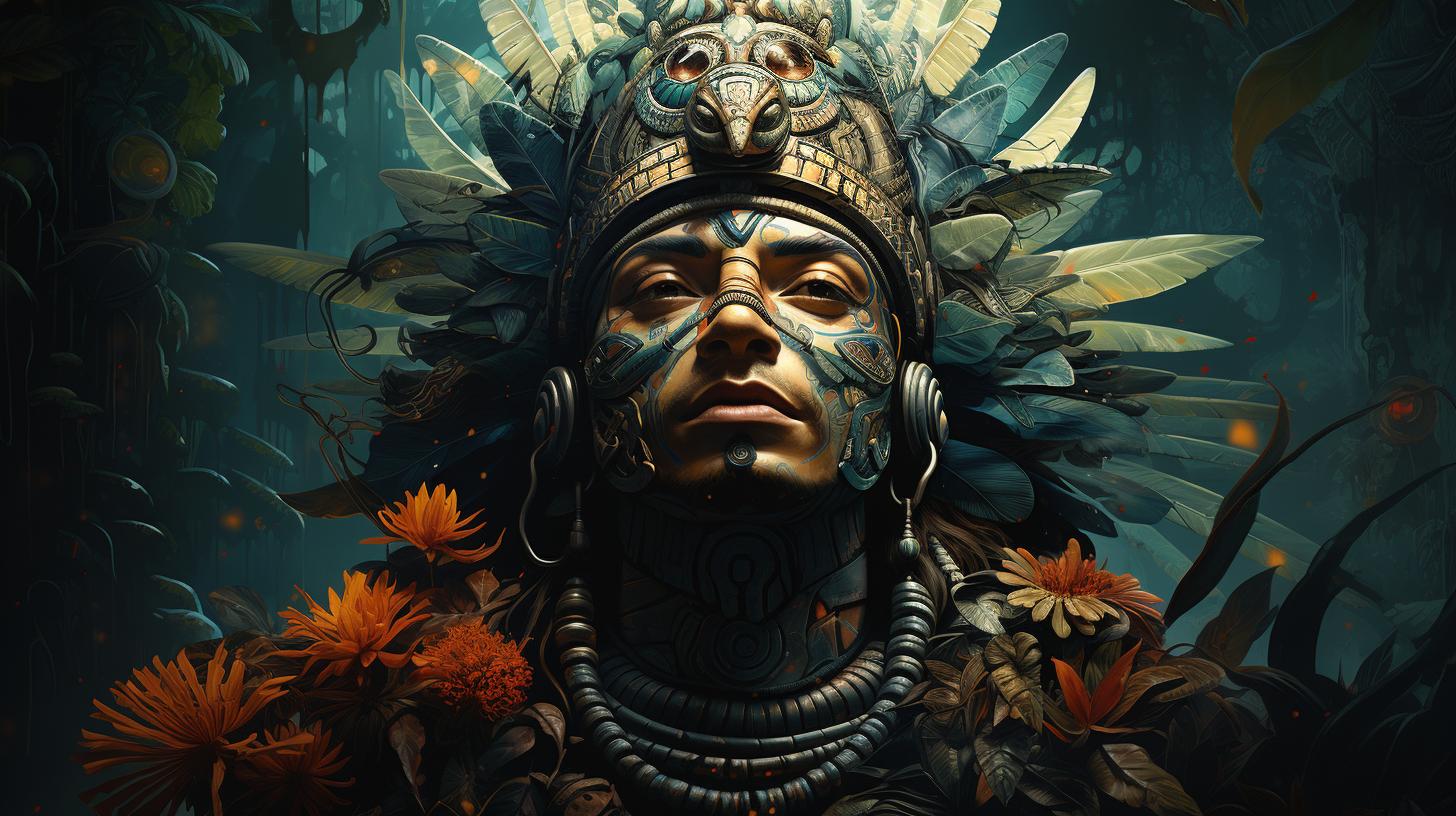Ek Chuaj: Exploring the Mysteries of the Maya God of Commerce and Cacao

Ek Chuaj, the Maya god of commerce and cacao, holds a significant place in Maya mythology. Represented with symbolic features, Ek Chuaj’s connection to trade and travel shaped the ancient Maya civilization.
Cacao, a key element in Ek Chuaj worship, played a vital role in rituals and festivities. As with any mythological figure, there are debates and controversies surrounding Ek Chuaj’s origins and cultural significance.
In this article, we will explore the role of Ek Chuaj in Maya mythology, its representation in art and archaeology, its relationship with other deities, and the importance of cacao in its worship.
The Role of Ek Chuaj in Maya Mythology
Ek Chuaj holds a significant place in Maya mythology, particularly as the god associated with commerce and cacao. This deity played a crucial role in the economic and cultural aspects of Maya civilization.
Ek Chuaj as the God of Commerce and Cacao
Ek Chuaj is revered as the god of commerce and trade among the Maya. The ancient Maya civilization thrived on trade networks, and Ek Chuaj was believed to oversee these economic activities.
Merchants and traders sought the blessings of Ek Chuaj for successful business ventures and safe travels.
Cacao held immense value in Maya society, not just as a commodity but also as a sacred food and elixir.
Ek Chuaj was closely associated with cacao, representing its significance in trade and as a symbol of wealth and prosperity.
Depiction and Symbolism of Ek Chuaj
The visual representation of Ek Chuaj often depicts the god with distinctive features. This includes eyes with black rims, a large drooping lip, and a dark or black body. The exact interpretation of the drooping lip remains uncertain, but it contributes to the unique appearance of this deity.
Ek Chuaj’s symbolism is undoubtedly connected to his role as the god of commerce and cacao. The presence of a backpack and a lance in his imagery symbolizes the tools and skills required for merchants and traders, who often had to defend themselves during their journeys.
Furthermore, Ek Chuaj’s representation as one of the deities associated with the alphabet, specifically the letter M, suggests the importance of this god within Maya cosmology and the intricate relationship between language, communication, and trade.
The association between Ek Chuaj and conflict might also explain the common tactics used by door-to-door and telemarketing salespeople, depicted as a modern manifestation of the god’s methods.
In conclusion, Ek Chuaj’s role as the god of commerce and cacao is deeply rooted in Maya mythology.
As a revered deity, Ek Chuaj played a vital role in supporting trade and economic activities among the Maya people, symbolizing their connection with commerce and embodying the spirit of entrepreneurial endeavors.
Ek Chuaj in Maya Art and Archaeology
Ek Chuaj’s presence in Maya art and archaeology provides valuable insights into the cultural significance and worship of this deity. The representations of Ek Chuaj can be found in codices and various artistic depictions throughout the Maya civilization.
Representations of Ek Chuaj in Codices and Artwork
The Maya codices, such as the Madrid Codex and the Dresden Codex, offer glimpses into the artistic rendering of Ek Chuaj. These ancient manuscripts depict Ek Chuaj with distinct features, including his characteristic black-bordered eyes and a large, drooping lip or nose.
Furthermore, Ek Chuaj’s representation in other artwork, such as murals and pottery, showcases his association with commerce and cacao. These artistic depictions often portray Ek Chuaj carrying a backpack and a spear, symbolizing the traders and travelers who relied on his protection during their journeys.
Ek Chuaj in Ancient Maya Sites
Ancient Maya sites provide physical evidence of the veneration of Ek Chuaj. Temples and structures dedicated to this deity have been discovered, emphasizing the importance of Ek Chuaj in Maya religious practices.
Inscriptions and carvings found in these sites depict scenes of Ek Chuaj engaged in commercial activities, emphasizing his role as the god of commerce and cacao. These representations often depict Ek Chuaj alongside other deities, highlighting the interconnectedness of Maya religious beliefs.
Additionally, artifacts excavated from ancient Maya sites, such as jewelry and figurines, display Ek Chuaj’s image. These items, adorned with symbols associated with commerce and the deity’s distinct features, exemplify the reverence and cultural significance attributed to Ek Chuaj.
In conclusion, the representations of Ek Chuaj in Maya art and archaeology provide valuable insights into the worship and cultural importance of this deity in the Maya civilization. The artistic depictions found in codices, murals, pottery, and the physical presence of Ek Chuaj in ancient Maya sites emphasize the deity’s role as the god of commerce and cacao, as well as the interconnectedness of Maya religious beliefs.
- Maya codices and artwork depict Ek Chuaj with specific features
- Ancient Maya sites showcase temples and structures dedicated to Ek Chuaj
- Inscriptions and carvings illustrate Ek Chuaj’s involvement in commercial activities
- Excavated artifacts highlight the significance of Ek Chuaj in Maya religious practices
The Relationship Between Ek Chuaj and Other Maya Deities
The worship of Ek Chuaj, the Maya god of commerce and cacao, was intertwined with the beliefs and practices associated with other Maya deities.
This section explores the connections between Ek Chuaj and other merchant deities, as well as the influence of Ek Chuaj on trade and travel in Maya civilization.
Connections Between Ek Chuaj and Other Merchant Deities
Ek Chuaj shared similarities and associations with other deities linked to trade and commerce in Maya mythology.
One such deity is Yacatecuhtli, the central Mexican god of merchants. Scholars believe that Ek Chuaj may have been an addition or an imported deity based on Yacatecuhtli, integrating into the Mayan belief system over time.
Representations of Ek Chuaj often depict him carrying a backpack and a spear, symbolizing the tools of trade and the need for protection during travel. These objects align with the attributes commonly associated with merchants and travelers who frequently faced threats and challenges on their journeys.
Ek Chuaj’s Influence on Trade and Travel in Maya Civilization
Ek Chuaj played a significant role in facilitating trade and travel within the Maya civilization. As the god of commerce, Ek Chuaj was invoked by merchants and traders to ensure safe journeys and prosperous business transactions.
Incense was offered to Ek Chuaj as a prayer for a secure return during trading expeditions.
The ancient Maya had a vast network of trade routes that connected different regions, with merchants often traveling long distances to exchange goods.
Ek Chuaj’s association with trade and his role as a protective deity provided comfort and guidance to merchants embarking on these journeys.
Through the influence of Ek Chuaj and other merchant deities, Maya society thrived economically through extensive trade networks, supported by agricultural practices such as cacao cultivation, which served as a form of currency in commercial transactions.
- Ek Chuaj’s role in facilitating trade and travel
- Offerings and prayers for safe journeys
- The significance of trade routes in Maya civilization
- The economic impact of Ek Chuaj’s influence on commerce
Understanding the relationship between Ek Chuaj and other Maya deities provides valuable insights into the interconnectedness of belief systems and the vital role of commerce in ancient Maya society.
The Importance of Cacao in Ek Chuaj Worship
Cacao held a significant role in the worship of Ek Chuaj, the Maya god of commerce. It was considered a sacred offering to appease and honor the deity. The association between Ek Chuaj and cacao reflects the economic importance of the crop in Maya society, where cacao beans were used as currency in commercial transactions.
Cacao as a Sacred Offering to Ek Chuaj
Cacao was viewed as a precious and spiritually significant substance, often used as a sacrificial offering to Ek Chuaj. It symbolized fertility, wealth, and abundance, all of which were essential aspects of commerce and trade.
Maya merchants and traders would present cacao beans, cacao-based drinks, or elaborately prepared cacao products as offerings during rituals and ceremonies to seek the god’s favor and ensure prosperous business endeavors.
Evidence from Maya Art and Iconography
Maya art and iconography provide insights into the importance of cacao in Ek Chuaj worship. In depictions, Ek Chuaj is often portrayed with cacao pods or carrying a bundle of cacao beans, emphasizing his role as the overseer of the chocolate realm.
The presence of cacao-related motifs and imagery in temples, murals, and pottery further highlights the significance of cacao in religious and commercial contexts.
Ek Chuaj’s Role in Rituals and Festivities Related to Cacao
Rituals and festivities honoring Ek Chuaj and celebrating cacao played a crucial role in Maya society. During specific ceremonial occasions, farmers, merchants, and other community members would come together to pay homage to Ek Chuaj and give thanks for the abundance of cacao.
These events involved offerings, prayers, dances, and feasts, fostering a sense of community and reinforcing the importance of cacao in trade and commerce. The rituals aimed to ensure successful harvests, safe travels, and prosperous business ventures.
Interactions with Other Deities
Cacao-related rituals often intertwined with ceremonies dedicated to other deities, such as Chac, the god of rain, and Ixchel, the goddess of fertility. The combination of these different elements reflects the interconnectedness of nature, agriculture, and commerce within Maya religious practices.
- The offerings of cacao to Ek Chuaj symbolized the interconnectedness of commerce, agriculture, and spirituality
- Rituals and festivities involving cacao served as a way to seek the god’s blessings for successful business endeavors
- Cacao beans, cacao-based drinks, and prepared cacao products were presented as sacred offerings
- These rituals fostered a sense of community and gratitude for the abundance of cacao
- Cacao-related ceremonies often intertwined with rituals dedicated to other deities
Interpretations and Controversies Surrounding Ek Chuaj
The deity Ek Chuaj has sparked scholarly debates regarding its origins and cultural significance.
Additionally, there have been concerns about cultural appropriation and misinterpretations regarding its representation. This section delves into these interpretations and controversies, shedding light on different perspectives and discussions surrounding Ek Chuaj.
Scholarly Debates on Ek Chuaj’s Origins and Cultural Significance
Experts in Maya studies have engaged in debates concerning the origins and cultural significance of Ek Chuaj. Some scholars believe that Ek Chuaj may have emerged as an imported deity based on Yacatecuhtli, the central Mexican god of merchants.
This theory suggests that Ek Chuaj was introduced to the Maya region and integrated into their belief system. However, there are ongoing discussions about whether Ek Chuaj represents a true Maya deity or a foreign addition to their pantheon.
Cultural Appropriation and Misinterpretations of Ek Chuaj’s Representation
Ek Chuaj’s image and symbolism have become popular in contemporary culture, leading to concerns of cultural appropriation and misinterpretation. The commercialization of Ek Chuaj’s image, such as in merchandise and branding, has raised questions about the commodification and distortion of Maya mythology.
Furthermore, misinterpretations of Ek Chuaj’s representation and the meaning behind its visual elements have sparked debates among scholars and practitioners of Maya studies.
In order to foster a deeper understanding of Ek Chuaj and respect for Maya culture, it is essential to engage in respectful and informed discussions about its origins, cultural significance, and proper representation.
.




















